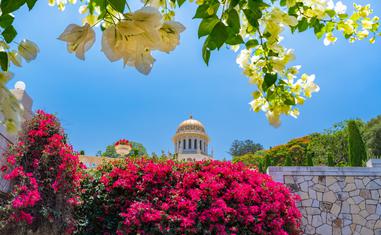The views expressed in our content reflect individual perspectives and do not represent the authoritative views of the Baha'i Faith.
A new religion starts when a prophet first announces a revelation, just as the Buddha did to his first two disciples, Trapusa and Bahalika; or as Jesus Christ did to John the Baptist.
In this way, a messenger of God receives a revelation from its mystical source, and begins to share the new and yet ancient wisdom with others. The prophet’s message spreads, more and more people accept and follow it, and in that way the revelation begins to alter our human reality, upending the old ways and eventually creating entire civilizations.
This mysterious process, inaugurated by one person without wealth or worldly power, ultimately becomes the life-sustaining spiritual basis of the lives of billions of people.
RELATED: The World’s Baha’is Commemorate the Martyrdom of the Bab
That’s precisely how the Bab, the young herald of the Baha’i Faith and the founder of its revolutionary precursor the Babi Faith, declared his mission on May 22, 1844 to a young seeker named Mulla Husayn.
Tens of thousands of Mulla Husayn’s fellow Persians followed his example by becoming believers – but the government and the clerical establishment opposed, persecuted, and killed thousands of early Babis. Six years and six weeks later, on July 9th, 1850, the Bab died in a hail of bullets from a firing squad, summarily executed by political and religious authorities who feared the potent power of the Bab’s message, the stunningly rapid growth of his new Faith, and the sacrificial devotion evinced by tens of thousands of his followers.
The Bab – a title which means “the Gate” – opened the way for Baha’u’llah’s revelation, and, Baha’is believe, for the eventual establishment of the unity of humanity. So who was the Bab, and why, on this day each year, do millions of people all around the world celebrate his declaration of a new Faith?
From a simple biographical perspective, the Bab was a young man named Siyyid Ali Muhammad, born in Shiraz, in the province of Fars, Persia in 1819. (Siyyid is a title that means “descended from the lineage of the prophet Muhammad”)
Born into a family of merchants and traders; raised by his maternal uncle after the premature death of his father in 1826; a mystic descended from many generations of mystical Sufis; known from early childhood for his wisdom, intelligence, and humility; the Bab – who was executed when he was just 30 years old – inaugurated a spiritual movement comparable only to the birth of Christianity.
Shoghi Effendi, the Guardian of the Baha’i Faith, wrote this brief summary of the parallels in his book God Passes By:
The passion of Jesus Christ, and indeed His whole public ministry, alone offer a parallel to the Mission and death of the Bab, a parallel which no student of comparative religion can fail to perceive or ignore. In the youthfulness and meekness of the Inaugurator of the Babi Dispensation; in the extreme brevity and turbulence of His public ministry; in the dramatic swiftness with which that ministry moved towards its climax; in the apostolic order which He instituted, and the primacy which He conferred on one of its members; in the boldness of His challenge to the time-honored conventions, rites and laws which had been woven into the fabric of the religion He Himself had been born into; in the role which an officially recognized and firmly entrenched religious hierarchy played as chief instigator of the outrages which He was made to suffer; in the indignities heaped upon Him; in the suddenness of His arrest; in the interrogation to which He was subjected; in the derision poured, and the scourging inflicted, upon Him; in the public affront He sustained; and, finally, in His ignominious suspension before the gaze of a hostile multitude—in all these we cannot fail to discern a remarkable similarity to the distinguishing features of the career of Jesus Christ.
What began a few hours after sunset on May 22, 1844 – a release of spiritual energy, new era of faith, a renewal of the eternal promise of religion itself – has continued unbroken until now.
Soon after his declaration many thousands became followers of the Bab, who abrogated the laws of the past and declared that he had come to pave the way for another prophet of God, the “Promised One of All Ages,” “the One Whom God shall make manifest,” who would establish a peaceful, universal, and unifying global religion.
Historians who study the first stirrings of the societal transformation the Bab initiated often remark on the virulent and violent persecution his message engendered. This passage, from Dr. J.E. Esslemont’s Baha’u’llah and the New Era, offers a glimpse:
The fire of [the Bab’s] eloquence, the wonder of His rapid and inspired writings, His extraordinary wisdom and knowledge, His courage and zeal as a reformer, aroused the greatest enthusiasm among His followers, but excited a corresponding degree of alarm and enmity among the orthodox Muslims. The Shi’ih doctors vehemently denounced Him, and persuaded the Governor of Fars, namely Husayn Khan, a fanatical and tyrannical ruler, to undertake the suppression of the new heresy. Then commenced for the Bab a long series of imprisonments, deportations, examinations before tribunals, scourgings and indignities, which ended only with His martyrdom in 1850 … In consequence of these declarations of the Bab and the alarming rapidity with which people of all classes, rich and poor, learned and ignorant, were eagerly responding to His teaching, attempts at suppression became more and more ruthless and determined. Houses were pillaged and destroyed. Women were seized and carried off. In Tihran, Fars, Mazindaran, and other places great numbers of the believers were put to death. Many were beheaded, hanged, blown from the mouths of cannon, burnt or chopped to pieces. Despite all attempts at repression, however, the movement progressed.
RELATED: The Joyous Birth of the Bab
Abdu’l-Baha described the Declaration of the Bab and the sacrifices his followers made in a speech he gave in the United States on the anniversary of the Bab’s declaration:
On this day in 1844 the Bab was sent forth heralding and proclaiming the Kingdom of God, announcing the glad tidings of the coming of Baha’u’llah and withstanding the opposition of the whole Persian nation. Some of the Persians followed Him. For this they suffered the most grievous difficulties and severe ordeals. They withstood the tests with wonderful power and sublime heroism. Thousands were cast into prison, punished, persecuted and martyred. Their homes were pillaged and destroyed, their possessions confiscated. They sacrificed their lives most willingly and remained unshaken in their faith to the very end. Those wonderful souls are the lamps of God, the stars of sanctity shining gloriously from the eternal horizon of the will of God.
Naturally, Baha’is rejoice and celebrate annually on the anniversary of the Declaration of the Bab, which first sounded the great call for the unity of all peoples, cultures, nations and religions. The Bab wrote: “Know thou that first and foremost in religion is the knowledge of God. This attaineth its consummation in the recognition of His divine unity … “
New religions always begin when a prophet of God receives a divine revelation, a mystical transference of inspiration, knowledge and spiritual power from the Creator. With Buddha, with Abraham, with Jesus, with Muhammad, with the Bab and Baha’u’llah, this same basic pattern occurred. Each of those prophets opened the path to a new level of human consciousness and societal development.
The Bab, whose declaration we celebrate today, brought into being the means and the message to make the eventual establishment of the unity of humanity possible.

















Comments
Sign in or create an account
Continue with Facebookor